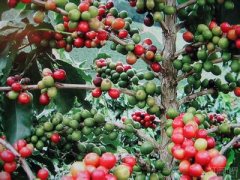Twelve famous high-quality coffee producers in Costa Rica

The origin of coffee in Costa Rica:
High-quality Costa Rican coffee is called "extra hard beans". This kind of coffee can grow above 1500 meters above sea level. Altitude has always been a problem for coffee growers. The higher the altitude, the better the coffee beans, not only because the higher altitude can increase the acidity of the coffee beans and thus increase the flavor, but also because the night temperature at the higher altitude is lower, which can make the trees grow slowly, thus making the coffee beans have a stronger flavor. In addition, due to the high altitude drop caused by sufficient rainfall, is also very beneficial to the growth of coffee trees.
Located in the south of the country's capital, SanJose, Tarasu is one of the most valued coffee growers in the country. LaMinitaTarrazu coffee is a local product, but the production is limited. It is grown on a piece of land called LaMinita, which is owned by the last three generations of the McAlpine family in the UK.
Other coffees worth mentioning are JuanVinas,PR, H.Tournon, Windmill,SHB, Montebello and SantaRosa. Fine coffee is generally grown in Heredia and the central canyon. In addition, another kind of coffee is Sarchi (Saatchi is one of the five towns that represent the Coffee Road in Gosgarica), which grows on the slopes of the PoasVolcano volcano, 53 kilometers from San Jose. Saatchi, founded in 1949, has a land area of 30770 hectares and grows sugar cane and coffee.
The characteristics of Costa Rican coffee:
Tarrazu in Costarica is one of the major coffee producing areas in the world, with a light and pure flavor and pleasant aroma.
Flavor: excellent, smooth, acidic, high grade, with attractive aroma
Suggested baking method: medium, can also be deep baking
★★★: excellent
The market for Costa Rican coffee:
Coffee exports account for 25% of Costa Rica's total exports. Costa Rica has also benefited from the establishment of the Central American Institute for Agricultural Research (TurrialbaoftheCentralAmericanAgriculturalResearchlnstitute, referred to as IAAC) in Tarasu, which is an important international research centre.
Costa Rica's coffee industry, originally controlled by the Costa Rican Coffee Industry Company (InstitutodelCafedeCostaRica, ICAFE), has been taken over by the official Coffee Committee (OficinadelCafe). Among the exported coffee, those products that are considered to be of substandard quality are colored with blue vegetable dyes and then transferred back to China for sale. Coffee consumed domestically (dyed blue or last dyed) accounts for about 10% of total production, and local per capita coffee consumption is twice that of Italy or the United States.
In addition, while Costa Rica has many advantages in growing coffee at higher elevations, the resulting additional transport costs must be taken into account, which is likely to make coffee production unprofitable. The coffee industry in Costa Rica has adopted new technologies to increase efficiency, including the use of "electric eyes" to select beans and identify coffee beans of irregular size.
Important Notice :
前街咖啡 FrontStreet Coffee has moved to new addredd:
FrontStreet Coffee Address: 315,Donghua East Road,GuangZhou
Tel:020 38364473
- Prev

Yemeni coffee beans from 12 famous high-quality coffee producing areas
Before the 6th century AD, Yemen was called Arabia, so coffee trees shipped from Yemen to other places were also called Arabian coffee trees. But the origin of these trees is Ethiopia. Yemen is the first country in the world to produce coffee on a large scale as a crop. Today, coffee farmers in Yemen still use the same method to produce coffee as they did 500 years ago.
- Next

Hawaii's 12 Best Coffee Places
After nearly two centuries of efforts to grow coffee in Hawaii, the term Kona has become almost synonymous with "quality." Hawaii has a geographical advantage for growing coffee, but historically, coffee has been grown on a bumpy road since coffee trees were first introduced to the island in 1825. Even today, it's impossible for anyone
Related
- Guji coffee producing area of Guji, Ethiopia: Humbela, Shakiso, Wulaga
- What is the most expensive variety of Qiloso in BOP multi-variety group?
- How to store the coffee beans bought home?
- Why are Yemeni coffee beans so rare now?
- Ethiopian Sidamo all Red Fruit Sun Sun Santa Vini Coffee beans
- SOE is mostly sour? What does it mean? Is it a single bean? what's the difference between it and Italian blending?
- Is Italian coffee beans suitable for making hand-brewed coffee?
- How to choose coffee beans when making cold coffee? What kind of coffee beans are suitable for making cold coffee?
- Just entered the pit to make coffee, what kind of coffee beans should be chosen?
- Can only Japan buy real Blue Mountain Coffee? What are authentic Jamaican Blue Mountain coffee beans?

